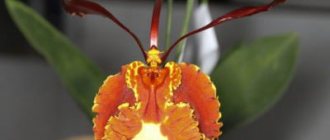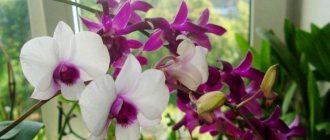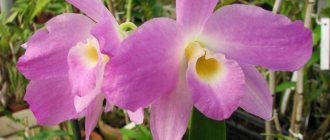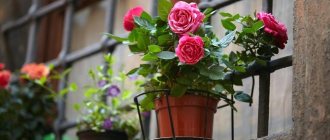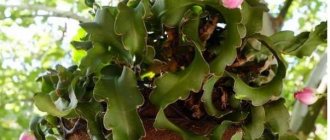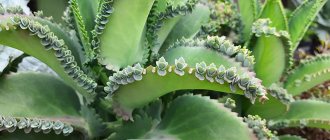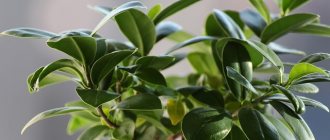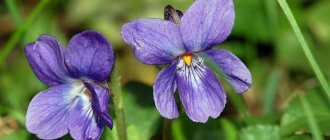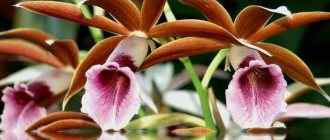The popularity of exotic flowers is gaining momentum. Orchids attract the attention of not only experienced flower growers and breeders, but also beginners.
There are legends and myths about the birth of this amazing flower, which are passed from mouth to mouth and maintain the mystery of the plant. In the wild, orchids live in the most unusual places : in the tropics - on trees, in the mountains - on rocks and limestone, there are even underground species. Their unusual appearance, sometimes terrifying, inspired fear in ancient times.
Some species actually belong to predatory representatives. Now the most unusual shapes and colors of orchids are a decoration for any home flower collection.
The exotic nature of its growth and image gave rise to the myth about the capricious nature of an exotic flower . In fact, at home, an orchid requires minimal care, but with a strict regime .
Orchid roots are adapted to the most unfavorable conditions: drought, humidity, heat and coolness. In the tropics the climate is unpredictable.
We will tell you about the varieties of orchids: Angrekum, Ascocenda, Bulbophyllum, Gulu, which develop well at home and bloom all year round.
Description
The genus Ascocenda is a full member of the Orchid family.
But it owes its appearance not to nature, but to man. These wonderful plants are the successful result of crossing two genera: Vanda and Ascocentrum. From the first, the plant received large flowers, from the second, compact sizes and an expanded color palette of multi-flowered inflorescences. At the same time, the parents were a little “stingy”, not passing on their inherent fastidiousness. The beautiful Ascocenda blooms 3-6 times a year and is considered one of the easiest orchids to care for. Beginners and experienced gardeners willingly add these plants to their flower collections.
Ascocenda has no pseudobulbs. On a strong, erect stem, uniformly colored green leaves are located opposite. The roots are thick and long, sometimes the same length as the entire plant. Peduncles bear up to 25 buds. They open almost simultaneously, turning into large flowers of pink, red, crimson, purple, blue, orange, and brown colors. Often their surfaces are decorated with dashes and spots of other shades.
Flowering lasts up to 1.5 months. Ascocenda is also suitable for cutting. However, a flower placed in a vessel with water lives much less.
Lighting
This plant does not require any specific level of light. So, it feels quite comfortable both on a window of northern and southern orientation (shading from the midday sun is required). But there is one nuance here, namely, the illumination should be at the same level all the time without changes. In the cold season, the plant must be supplemented with phytolamps, and the daylight hours must last at least 12 hours. Additional lighting is also recommended in the summer, when the weather outside is very cloudy.
If there is too much light, the leaves will become reddish and wrinkled, and if there is not enough light, they will take on a dark green hue.
Growing
Ascocenda reacts negatively to transplants. It is recommended to move to a new container in cases of extreme necessity: during growth or decomposition of the substrate. The key to success is careful handling of roots. Damaged, rotten or dried ones are removed. After transplantation, the plant is kept in dry conditions.
Like the popular Vanda, Ascocenda prefers to exist with its root system released into the wild. Therefore, when placed without soil in a basket or on a block, the orchid grows faster and blooms more often.
Successful propagation of a flower requires not only experience, but also luck. Even experienced flower growers often fail. The fact is that Ascocenda rarely indulges in the appearance of lateral shoots suitable for rooting. That is, the only planting material remains the apical cutting. It can only be cut from a strong plant. The cuttings are dried for several days and then placed in a clean substrate. You will need a stationary or improvised mini-greenhouse (plastic bag). It is necessary to maintain a ratio of increased humidity to 80% and minimal watering until its own roots grow and the plant reaches 15–20 cm in height.
Reproduction of Ascocenda orchid at home
Seed propagation is only possible for specialists, since this requires special conditions, and the process of plant development takes about 2 years. In addition, from a hybrid you will not get seedlings with the same characteristics as the parent plant.
Reproduction by shoots
Flower buds rarely produce shoots, which can be separated after their roots have formed. This process should be assisted: remove the scale from the flower bud, lubricate it with lanolin, in which 5 mg of benzoaminopurine and 5 drops of transcinnamic acid are dissolved.
Propagation by cuttings
The Ascocenda orchid can also be propagated by cuttings:
- For a healthy orchid, cut off the top with part of the stem and a couple of leaves. To do this, use a disinfected tool, and burn the cut area on the mother plant with brilliant green or sprinkle it with charcoal.
- The cutting area should be covered with a film: let it sit for a while and dry.
- Root the cutting by dipping the tip in a rooting stimulator, planting it in damp sphagnum moss, and keep it at 80% air humidity (a closed aquarium is ideal).
First steps after purchase
When transporting Ascocenda, the main thing is to prevent damage to the roots. Overheating or hypothermia does not pose a particular danger to the plant. Keeping this orchid in quarantine is more a tribute to tradition than a necessity. Pests attack it extremely rarely. At first, watering is strictly limited or completely replaced by spraying.
Ascocenda does not like to move from place to place, so it is necessary to determine in advance where the flower will live. You should wait a little while replanting a blooming orchid. Depending on the chosen growing method (with an open or closed root system), after the flowers fall off, it is necessary to place Ascocenda in a pot with substrate, in a basket or on a block.
Diseases and pests of Ascocenda
This orchid is extremely susceptible to rot, which can affect the root system, growing point or leaves. It's all due to waterlogging. If the damage is severe, you will have to get rid of the plant. At the first manifestations, cut off the affected parts and treat with Benlat or Fundazol, be sure to bring the care back to normal.
Pests of Ascocenda are spider mites (they are not noticeable themselves, but they leave whitish cobwebs, and the surface of the leaves becomes covered with black dots from their bites) and scale insects (they form brown plaques-growths on the leaves). We get rid of the former by bathing in a warm shower (t 45 °C). To remove scale insects, soak a cotton swab in alcohol and wipe the leaves. If these measures do not help, resort to treatment with a special insecticidal preparation.
Secrets of success
Ascocenda likes abundant lighting and long daylight hours. Brief exposure of the flower to direct sunlight is not dangerous, however, in the summer months it is advisable to provide shading. The “origin” of light – natural or artificial – is not of fundamental importance. The need for lighting in winter or when placed on northern windows is fully satisfied by fluorescent lamps.
Ascocenda is a heat-loving orchid. Optimum daytime summer temperatures are +23–27°C, 16–22°C in winter. There is no need for special measures to organize night cold snaps. The plant is quite content with natural changes.
The life cycle of a flower does not include a period of rest. However, when the air temperature drops below +15°C, it can be “modeled”. Reduce watering, cancel fertilizing. A short rest stimulates flowering.
Without watering and moistening, Askocenda cannot exist. The water supply of a flower must be subject to the principle of reasonable sufficiency. A flooded root system and undried leaves and stems provoke the appearance of the most dangerous enemies of the orchid - all kinds of rot.
Ascocenda is fed every third watering with fertilizer for orchids. At low light levels and cold weather, fertilizing is canceled. In addition, you should not fertilize a newly transplanted, weakened plant or a specimen with damaged roots. The best results are obtained by using low concentration solutions.
Ascocenda flowering
How Ascocenda blooms photo of flowers
It can be observed in spring and autumn. From the axils of the leaves, the orchid produces one or several flowering stems; per year the ascocende produces about 6 of them. The racemose inflorescence has 15-25 corollas. They are shaped like pansies, about 5-8 cm in diameter, and come in warm yellow, orange, purple and dark red hues. Although the palette is not rich, the Ascocenda hybrid is widely popular along with Vanda. A chic brush often becomes part of a bouquet or a solo representative.
We stimulate flowering as follows:
- The difference between day and night temperatures must be 2-3 degrees Celsius. As a last resort, increase the discrepancy to 5-7 °C;
- Reduce watering by half;
- We shorten the daylight hours by 2 hours.
Such phenomena are stressful for the plant, so it is necessary to pay attention to the condition of the orchid.
Substrate mixture for planting
With the exception of Ascocenda and Vanda hybrids, which are kept with an open root system, most orchids at home are grown in a special substrate of pine bark and expanded clay, the fraction of which depends on the plant variety.
Sphagnum moss is also often added to this mixture - it retains moisture well and helps to better strengthen the roots of the plant in the pot.
Don’t be tempted by the availability of “ready-made” soils for orchids on sale - it is preferable to prepare the mixture yourself to take into account the requirements of your particular plant. In addition, it is not difficult, and all components individually are quite accessible.
Humidity.
Vanda, like all orchids, is a moisture-loving plant, but you should not try to increase air humidity through the frequency of watering. Spraying is also impossible to maintain the natural water content in the surrounding air to which this orchid is accustomed. Leaving water in the vase is not recommended, as this can damage the root system. The solution may be to purchase an air humidifier or spray the leaves once in the morning. There is no need to spray the roots, as they receive all the necessary moisture during watering. Water, naturally, should be very soft, or preferably distilled. Do not allow large drops to form, especially near the stem, or water to accumulate on it. This is fraught with rotting or, even worse, the development of fungal diseases. In general, the plant tolerates dry air, but not waterlogging. Do not spray in cloudy weather or in direct sunlight (burns will appear on the leaves). In the autumn-winter period, the frequency of spraying also needs to be reduced, as the illumination decreases.
Proper nutrition
Orchids have specific nutritional needs; they need regular feeding, but not often. It is recommended to fertilize the orchid by watering once a month during the growth of the vegetative part - the leaves. You can use any complex fertilizer with the addition of mineral and organic nutrients. The fertilizer should be formulated taking into account the characteristics of the orchid and its “predilections” in nutrition.
To avoid damaging the delicate roots of the orchid, follow the instructions and dosage when feeding. Fertilizer stimulates the growth and development of plants, guarantees lush coloring of leaves, lush and long-lasting flowering.

